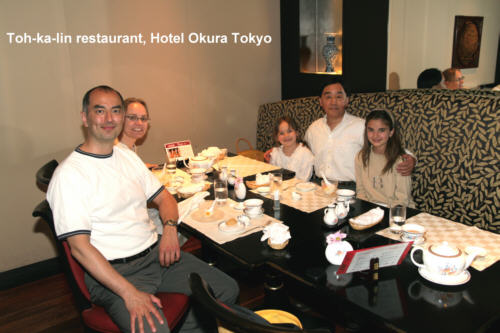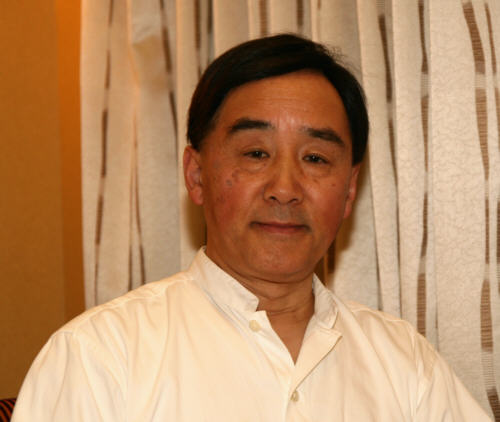
We landed in Tokyo on a sunny morning with a temperature of 23 degrees, which was a plus of 15 degrees from where we came from – Denmark.
With the whole family together, Anette, Grandma, Elisabet and Viktoria, we first toured Kyoto for 4 days, Okinawa for 4 days, after which we had a wonderful family stay in Tottori for 5 days.
On Okinawa we had rented a Mazda 6, so we got around the whole island. A visit to the Okinawa Budokan was also possible. As you know, the concrete building is fairly large with Dojoér (training halls) on 3 floors, stadium hall, Fitness center and large car park.
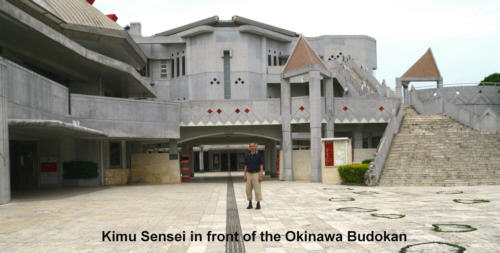
When you come from an ancient noble family, you also have to go through various "initiation rituals" as new members. The Yamana Itotani family has several "family temples". The oldest is the Yamana family's from the 11th century and the youngest is our "country name Itotani" temple of 450 years in Tottori.
When Anette (my wife) and Elisabet and Viktoria (daughters) were in Japan for the first time and with the family, they had to be "received and approved by the ancestors" through a one-hour long ritual performed by our Buddhist Abbot and his assistant monk. After mass and the beating of bells and "drums", they were approved and fully accepted into the family "with everything that goes with it".
I myself clearly remember my own admission as an 8-year-old in the Yamana and Itotani family's private temples. It's not something you forget like that. The rest of the days were in the family's lap and introduction through some of the family's history on a practical sight seeing trip.
By the way, we also visited the Watanabe Museum in Tottori, where to my great surprise I saw a collection of the famous Daimyo (County Lord) Takeda Shingen (1521-1573) samurai soldiers equipment, weapons and armor as well as two large painted old pictures of his 24 famous generals; including Yakami'-ryu's 23rd Soke Sensei, Saigusa Moritomo (1537-1575). Yep, the world is small J.
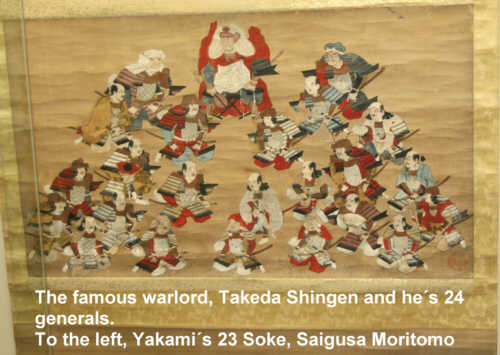
After that it was time for Tokyo, 4 days and for me the SST training camp!, which I had been looking forward to and preparing for intensively for a long time. It would be my Japan training camp 31, my SST training camp number 37 and 52nd visit to Japan.
I had been lucky and obtained a very good price at Hotel Okura, which I had stayed at for the first time in 1992. Many probably know Hotel Okura from my stories and from the website. It was my business and training hotel in the period 1992-1997 and 1999-2002, and has Jokokan historical significance, as at this hotel I was handed both my; Okuden (1992) Menkyo (1994), Menkyo Kaiden (1996) and Gokui Menkyo Kaiden (2000) makimonos and diplomas. In addition, it is SST's favorite hotel ("the KI is quite special"), and the high possible level in Jokokan EU/DK was founded and expanded at this hotel. So the ring was closed.
The phone rang shortly after arriving at the hotel - It was SST waiting in the lobby - the training camp had started.
Thirty minutes into the training camp after the completion of one special "technique", I was told that the training camp had now switched to a "Full Curriculum Evaluation Camp". All five system groups (curricula) had to be evaluated on the hide - "heart essence level".
Day one went with original Jikitai "hard - square body and mind" Okinawa karate-do curriculum with correctly connected kyusho points (energy points), tachi-ai kamae (fighting positions), Haké ("discharges"), waza (all in one). , Kokyuho (breath & kiai) through katas such as Yakami-ryu Naihanchi, Ten-i, Tensho and Kanku, which are significantly different from the level and performance of the gang.
Then it continued with Enshin "soft - soft circle body and mind" Hsingi, Kempo and Tai-chi techniques.
Then Yakami-ryu "moving meditation"; Aikijujutsu and Jujutsu techniques, and lots of martial arts theory to then be demonstrated in practice. When training ended at 23:00 my body was strained to the breaking point, and my mind and soul at the extreme limit of my ability.
The next morning to evening it was on the next main group of Bujitsu (ancient system techniques) Yakami-ryu Iai- and Kenjutsu, which consists of 8 subgroups. Such as Nukiai (Iaijutsu) which was to be performed after one demonstration of SST. Nukiai is the essence of the entire Yakami-ryu Iaijutsu and Kenjutsu curriculum.
The evaluation took place with one of SST's old family clenodies; an 800-year-old sword (Tachi) from the Kamakura period, which I was very honored by.
Then the entire Yakami-ryu Kokyu-Ho Curriculum with 16 subgroups, – and then continuing with the superstructure for the overall Curriculum with the five main groups.
It is the case that the Bujitsu Kodosoku Kai (see elaboration at the end of the article) syllabus curriculum is divided into five part curricula, each of which can be trained and specialized in separately. Graduating here is usually in DAN degrees, and after 2nd dan also in the old Bujutsu degrees. Most people choose this path, as there is room for everyone and the dropout percentage is relatively small – typically around the 20 % until brown belt and then increasing, which is mainly due to new life cycle and priorities.
The alternative is the "hard and slow way"; to learn and train all five part curricula, graduating in Makimono degrees (the ancient Bujutsu degrees), where the last degree; The "end station" is Menkyo Kaiden "Initiated master of all the martial arts". Few choose this path as the dropout rate is 90 % to the first or second bujutsu degree and then increasing, and most hit the "ceiling" at some point when the "costs" become too great.
For the "nerds", there is also a superstructure of four more ancient Bujutsu Makimono degrees, which are not awarded very often, as most have gone "cold" a long time before.
Rarely have I been so physically, mentally and spiritually exhausted. It is the hardest graduation process and training camp ever for me.
At the same time, SST had announced in advance that he wanted to see and train Elisabet (my eldest daughter and 4 years of training). There was a total of approx. 1 hour of teaching. She made Pinan 1, Pinan 4 and base.
In return for her, he made Naihanchi and Kanku, which Elisabet was speechless about (also me J). Afterwards he taught her bokuto, Goka no tachi and little hints.
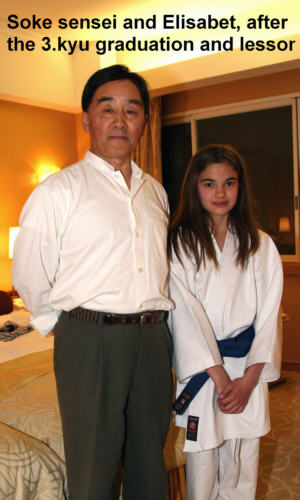
Otherwise, it is just to say that SST has achieved the highest peaks of martial arts – he is untouchable – a Meijin. It's the best camp I've ever had with him. He will be 70 in January 2008, and he still moves incredibly gracefully, powerfully and quickly - you can't understand it without having seen it with your own eyes. He IS the essence of the heart and execution of the martial art - he is one.
Soke Sensei Tonegawa subsequently announced the following graduations:
Yamana no Itotani Elisabet Hisa:
- 3.kyu, brown belt, Yakami-ryu Karate-do, - as well as a list of important things to work on.
Yamana no Itotani no Kimu, Sodenke Sensei;
In Yashin Mon.Yakami no Taijutsu;
- INKA “Mysterious great grandmaster of the martial arts”, Makimono
As well as an additional degree in part curriculum, Yakami-ryu Iai- and Kenjutsu,;
- Nuki-ai; 8th dan, Menkyo Kaiden, Makimono
And supplementary degrees in Yakami-ryu part curricula;
- Yakami-ryu Taijutsu, Menkyo Kaiden 8th dan
- Yakami-ryu Karate-do, Menkyo Kaiden, 8th dan
Other things:
Bujitsu Kodosoku kai is the collective name of the entire SST organization and systems. Jokokan is the name of all the Yakami-ryu dojos throughout the world.
Yashin Mon. Yakami no Taijutsu is the name of the collective umbrella of martial arts systems trained in Jokokan.
The martial arts system uses the main name; Bujitsu Kodosoku kai and their own organization's name, e.g. Genshi-kan in Denmark. It was therefore also a GREAT pleasure to learn that Jess Petersen and Steen Petersen from our SST sister organization in Denmark; GENSHI-KAN, in mid-April 2007, respectively, had been graduated and awarded the degrees 7.dan and 6.dan, Gensei-ryu Karate-do. A BIG congratulations from Jokokan Denmark!
